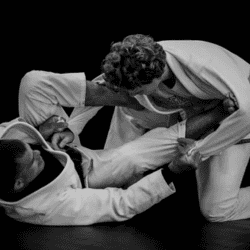What equipment do you need during your BJJ-training?

Brazilian Jiu-Jitsu (BJJ-training) is one of the most technical and challenging martial arts in the world. Whether you’re just starting or have been training for years, having the right gear is essential for training comfortably and safely. But what equipment do you need for a BJJ-training session? From the right gi to injury protection, this blog will guide you through all the essential gear for your BJJ training.
Why a good gi is important
The BJJ gi is the most recognizable part of your gear. This sturdy uniform is designed to withstand the intensity of grappling techniques, throws, and grips. Unlike a regular karate or judogi, a BJJ gi is often cut slightly tighter, making it harder for opponents to grip excess fabric.
A good gi is not just about comfort; it’s also a strategic choice. Fabric that is too light can tear easily, while a heavy gi may restrict your movement. That’s why choosing a gi that matches your style and weight class is crucial. Many BJJ practitioners own multiple gis to always have a fresh and dry set ready.
 The right fit and material
The right fit and material
A gi should fit well but not be too tight. During rolling, you need enough mobility to execute techniques properly and control your opponents. Cotton gis are popular for their durability, while lighter models, like ripstop gis, are more breathable and dry faster.
Most academies have specific rules regarding gi color and patches. Before purchasing a gi, it’s wise to check if your gym has any requirements. This way, you avoid showing up in a bright-colored gi while everyone else trains in white or blue.
Why a rashguard is essential
In No-Gi BJJ, where you train without a traditional gi, a rashguard is a must-have. This tight compression shirt protects your skin from abrasions and helps wick away sweat faster. Additionally, it prevents bacteria and fungi from spreading easily, which is crucial in close-contact sports like BJJ.
A good rashguard is made from breathable, elastic material and offers light compression to reduce muscle fatigue. Many BJJ practitioners also wear rashguards under their gi for extra protection and to extend the lifespan of their gi.
Spats for extra protection
Spats – long compression leggings – are ideal for both Gi and No-Gi training. They help prevent abrasions and skin infections while providing extra support for your legs. Especially in ground fights, where you have a lot of friction with the mat, quality spats protect your skin and improve mobility.
As with rashguards, choosing breathable material is key. Cotton is often too heavy and absorbs too much moisture, while synthetic fabrics like polyester and spandex are better suited for intense training.
 BJJ Belt: a symbol of progress
BJJ Belt: a symbol of progress
In BJJ, your belt is not just an accessory – it’s a symbol of your progress and skill level. The color of your belt indicates your rank, from white for beginners to black for the most experienced fighters. Achieving a higher belt requires months or even years of hard training and dedication.
Aside from the belt color, wearing a sturdy, well-tied belt is important. A loose belt needs constant retying, which can be annoying during rolling. Most BJJ belts are made from thick cotton, ensuring they stay in place and last longer.
How to choose the right belt?
Although your belt color is determined by your skill level, there are different brands and styles to choose from. Some belts are thicker and stiffer, while others are softer and more flexible. Choose a belt that stays in place and feels comfortable so you can fully focus on your techniques instead of constantly adjusting it.
Protection: preventing injuries and training safely
A quality mouthguard is essential, especially during intense sparring sessions. Accidental elbows, knees, or shoulders can hit your mouth, causing serious injuries if you’re unprotected. A well-fitted mouthguard absorbs impact and prevents long-term dental issues.
Many BJJ practitioners opt for a custom-fitted mouthguard, as it is more comfortable and offers better protection than standard models. Investing in a high-quality mouthguard is worthwhile since dental treatments can be far more expensive than a good mouthguard.
Ear guards: prevent ‘cauliflower ear’
A common issue among BJJ practitioners is “cauliflower ear,” a thickening of the ear cartilage caused by repeated impact. This happens when the ears frequently get bruised from hard grips or pressure on the mat.
To prevent this, some BJJ fighters wear ear guards – special protectors that shield the ears during rolling. While not everyone finds them comfortable, they can make a big difference if you’re prone to ear injuries.
BJJ Gear: investing in your performance
Having the right equipment is not just about comfort; it also affects your performance and safety. A sturdy gi, a reliable rashguard, and protective gear like a mouthguard ensure that you can train without worries. By investing in high-quality gear, you give yourself the best chance to grow as a BJJ practitioner.
Looking for the best BJJ gear? Check out our premium gis, rashguards, and protective equipment in the Fightstyle webshop and train like a pro!


 Gratis verzending vanaf €50
Gratis verzending vanaf €50